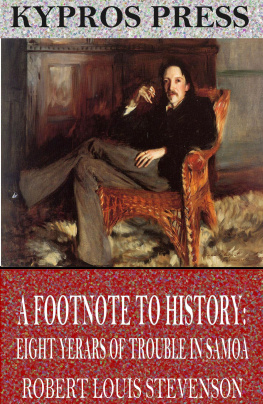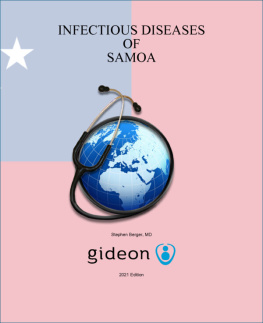To the Girls of Tau
This Book Is Dedicated
Ou te avatu
lenei tusitala
ia te outou
O Teinetiti ma le Aualuma
o Ta
Contents
Guide
I am indebted to the generosity of the Board of Fellowships in the Biological Sciences of the National Research Council whose award of a fellowship made this investigation possible. I have to thank my father for the gift of my travelling expenses to and from the Samoan Islands. To Prof. Franz Boas I owe the inspiration and the direction of my problem, the training which prepared me to undertake such an investigation, and the criticism of my results.
For a co-operation which greatly facilitated the progress of my work in the Pacific, I am indebted to Dr. Herbert E. Gregory, Director of the B. P. Bishop Museum and to Dr. E. C. S. Handy and Miss Stella Jones of the Bishop Museum.
To the endorsement of my work by Admiral Stitt and the kindness of Commander Owen Mink, U. S. N., I owe the co-operation of the medical authorities in Samoa, whose assistance greatly simplified and expedited my investigation. I have to thank Miss Ellen M. Hodgson, Chief Nurse, the staff nurses, the Samoan nurses, and particularly G. F. Pepe for my first contacts and my instruction in the Samoan language. To the hospitality, generosity, and sympathetic cooperation of Mr. Edward R. Holt, Chief Pharmacist Mate, and Mrs. Holt, I owe the four months residence in their home which furnished me with an absolutely essential neutral base from which I could study all the individuals in the village and yet remain aloof from native feuds and lines of demarcation.
The success of this investigation depended upon the co-operation and interest of several hundred Samoans. To mention each one individually would be impossible. I owe special thanks to County Chief Ufuti of Vaitogi and to all the members of his household and to the Talking Chief Lolo, who taught me the rudiments of the graceful pattern of social relations which is so characteristic of the Samoans. I must specially thank their excellencies, Tufele, Governor of Manua, and County Chiefs Tui Olesega, Misa, Sotoa, Asoao, and Leui, the Chiefs Pomele, Nua, Tialigo, Moa, Maualupe, Asi, and the Talking Chiefs Lapui and Muao; the Samoan pastors Solomona and Iakopo, the Samoan teachers, Sua, Napoleon, and Eti; Toaga, the wife of Sotoa, Faapuaa, the Taupo of Fitiuta, Fofoa, Laula, Leauala, and Felofiaina, and the chiefs and people of all the villages of Manua and their children. Their kindness, hospitality, and courtesy made my sojourn among them a happy one; their co-operation and interest made it possible for me to pursue my investigation with peace and profit. The fact that no real names are used in the course of the book is to shield the feelings of those who would not enjoy such publicity.
For criticism and assistance in the preparation of this manuscript I am indebted to Dr. R. F. Benedict, Dr. L. S. Cressman, Miss M. E. Eichelberger, and Mrs. M. L. Loeb.
M. M.
The American Museum of Natural History,
New York
March 1928
When my mother, Margaret Mead, was ready to seek a publisher for her first book, Coming of Age in Samoa, she found her way to William Morrow, the head of a new publishing company, and he gave her a key suggestion for the rest of her career, that she add more about what all this means to Americans. This set a course she followed throughout her life, establishing not only the appeal of anthropology as a depiction of the exotic but as a source of self-knowledge for Western civilization. The last chapter of Coming of Age laid out a theme for the years ahead: Education for Choice.
Even before World War II, still using the terminology of her time that now seems so outmoded and speaking of primitives or even of savages, she believed that Americans should learn not only about the peoples of the Pacific, but from them. And after almost every field trip she went back to William Morrow, now HarperCollins, where many of her books have remained in print ever since, offering new meanings to new generations of Americans. A century after her birth, they are offered once again, now for a new millennium, and today they still have much to offer on how individuals mature in their social settings and how human communities can adapt to change.
Several of Meads field trips focused on childhood. Writers have been telling parents how to raise their children for centuries; however, the systematic observation of child development was then just beginning, and she was among the first to study it cross-culturally. She was one of those feminists who have combined an assertion of the need to make women full and equal participants in society with a continuing fascination with children and a concern for meeting their needs. A culture that repudiated children could not be a good culture, she believed. [Blackberry Winter: My Earlier Years, New York: William Morrow and Company, 1972, p. 206.]
After studying adolescents in Samoa, she studied earlier childhood in Manus (Growing Up in New Guinea) and the care of infants and toddlers in Bali; everywhere she went, she included women and children, who had been largely invisible to earlier researchers. Her work continues to affect the way parents, teachers, and policy makers look at children. I, for one, am grateful that what she learned from the sophisticated and sensitive patterns of childcare she observed in other cultures resonated in my own childhood. Similarly, I have been liberated by the way her interest in women as mothers expanded into her work on gender (Sex and Temperament and Male and Female).
In addition to this growing understanding of the choices in gender roles and childrearing, the other theme that emerged from her fieldwork was change. The first postwar account of fieldwork that she brought to her longtime publisher described her 1953 return to the Manus people of New Guinea, New Lives for Old. This was not a book about how traditional cultures are eroded and damaged by change but about the possibility of a society choosing change and giving a direction to their own futures. Mead is sometimes labeled a cultural determinist (so obsessed are we with reducing every thinker to a single label). The term does reflect her belief that the differences in expected behavior and character between societies (for instance, between the Samoans and the Manus) are largely learned in childhood, shaped by cultural patterns passed on through the generations that channel the biological potentials of every child, rather than by genetics. Because culture is a human artifact that can be reshaped, rather than an inborn destiny, she was not a simple determinist, and her convictions about social policy always included a faith in the human capacity to learn. After the 1950s, Mead wrote constantly about change, how it occurs, and how human communities can maintain the necessary threads of connection across the generations and still make choices. In that sense, hers was an anthropology of human freedom.
Eventually, Mead wrote for Morrow the story of her own earlier years, Blackberry Winter, out of the conviction that her upbringing by highly progressive and intellectual parents had made her ahead of her time, so that looking at her experience would serve those born generations later. She never wrote in full of her later years, but she did publish a series of letters, written to friends, family, and colleagues over the course of fifty years of fieldwork, that bring the encounter with unfamiliar cultures closer to our own musings. Although













